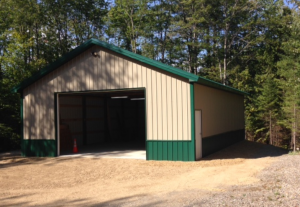How to Keep the Water Out of a Pole Barn
The post frame (pole barn) building has moved from the farm to suburbia. With the transition in building uses, having water flowing into a post frame business or residence is far less than desirable.
Dear Pole Barn Guru: My parents lived in a pole barn “lodge”. When there was a lot of snow and it blew against the building, as it melted water would get in under the walls. Grading was away from the building. Was the slab not poured high enough? Is there a way to seal bottom during construction that maybe wasn’t done properly? We want to have a pole barn home built, but need to educate ourselves on these details to make sure the work is done properly. Carolyn in Cleveland
Mike the Pole Barn Guru answers:
My bride and I happen to live in a post frame home in South Dakota, where in both snows and blows. Our building also has a huge footprint, being 84 feet wide and 60 feet deep. A six inch snowfall easily results in a berm along each side several feet in height.
For our slab on grade building, we made sure to have some serious slope away from all four sides of the structure.
From the 2015 IBC (International Building Code):
“1804.4 Site grading.
 The ground immediately adjacent to the foundation shall be sloped away from the building at a slope of not less than one unit vertical in 20 units horizontal (5-percent slope) for a minimum distance of 10 feet measured perpendicular to the face of the wall. If physical obstructions or lot lines prohibit 10 feet of horizontal distance, a 5-percent slope shall be provided to an approved alternative method of diverting water away from the foundation. Swales used for this purpose shall be sloped a minimum of 2 percent where located within 10 feet of the building foundation. Impervious surfaces within 10 feet of the building foundation shall be sloped a minimum of 2 percent away from the building.
The ground immediately adjacent to the foundation shall be sloped away from the building at a slope of not less than one unit vertical in 20 units horizontal (5-percent slope) for a minimum distance of 10 feet measured perpendicular to the face of the wall. If physical obstructions or lot lines prohibit 10 feet of horizontal distance, a 5-percent slope shall be provided to an approved alternative method of diverting water away from the foundation. Swales used for this purpose shall be sloped a minimum of 2 percent where located within 10 feet of the building foundation. Impervious surfaces within 10 feet of the building foundation shall be sloped a minimum of 2 percent away from the building.
Exception: Where climactic or soil conditions warrant, the slope of the ground away from the building foundation shall be permitted to be reduced to not less than one unit vertical in 48 units horizontal (2-percent slope).”
Regardless of siding type, a high quality and well-sealed building wrap (https://www.hansenpolebuildings.com/2012/11/house-wrap/) should be placed under the siding with the bottom edge at the bottom of the siding.
With steel siding, inside closures (https://www.hansenpolebuildings.com/2015/12/the-lowly-inside-closure/) can be placed between the building wrap and the steel siding to fill the voids created by the high ribs of the steel siding.
For residential purposes, I would strongly encourage the use of a raised wood floor over a crawl space as a living surface. It will add to comfort and should pretty well eliminate any potential for water infiltration around the base of the living area.






